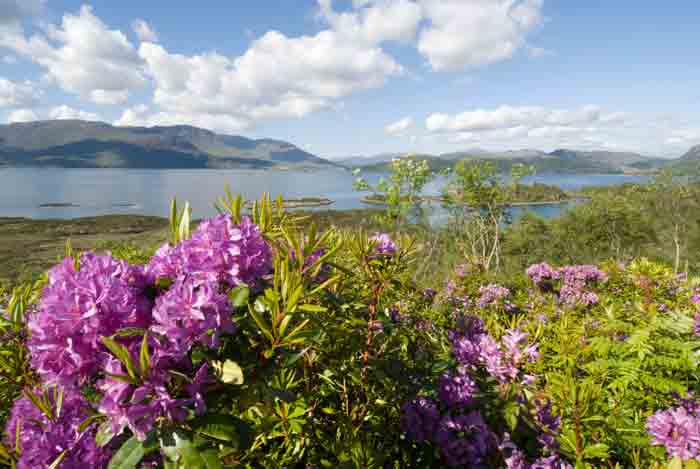National Trust for Scotland deals with invasive species on Torridon Estate
Rhododendron ponticum was much loved by Victorian plant-hunters, becoming a colourful addition to many Scottish estates because of their vibrant pink and purple blooms and their use as a cover for game birds.
However, more than a century later, the fast-growing shrubs have taken over large areas of the natural vegetation. Experts say the plant has become ‘one of the biggest threats to biodiversity and habitats in western Scotland‘ because of its love of the wet climate and acidic soil.
The National Trust for Scotland (NTS) has had a particular problem on its Torridon Estate where it has been using ‘stem injection’ to kill Rhododendron ponticum bushes spreading on the mountainous estate. The technique is efficient, particularly on the steep scree clad slopes and more environmentally friendly.
However, NTS experts have realized that residential gardens in villages such as Fasag were the last bastion for these plants and were a threat to the control work through re-seeding sites that have been cleared.
The (NTS) hope to deal with the problem by offering a unique ‘plant swop’. They have identified non-invasive alternative rhododendron cultivars, such as ‘Lord Roberts’ and ‘Cunningham’s White’, and will offer these in place of offending invasive varieties in public gardens.
Clearing Rhododendrons
Rob Dewar, the NTS’s nature conservation advisor is optimistic that removing this last domestic source of seeding will allow the NTS to better manage the wilderness of Torridon: “If left long enough, Rhododendron ponticum shuts out all the light coming in to ground, so nothing can grow and we lose that diversity,” he said. “They prevent access, have no use for grazing, and destroy native habitat, and if left they just keep spreading — they are a problem that we need to tackle.
“We have already removed most of the Rhododendron ponticum from the open ground on the Torridon estate, but it’s the remaining seed source which is the problem now, in and around people’s properties. We produced a newsletter inviting the community to participate in the plant swap scheme with some positive response.
“We are offering to remove the plants from public gardens and replace them with non invasive cultivars that will grow quite quickly to replace them. It’s worth remembering that one single rhododendron plant can send out thousands of seeds and then we have an ongoing control issue.”
In another NTS initiative the removed rhododendron wood is being used to make ‘eco-charcoal’ at several sites across the Highlands. Charcoal kilns were once a familiar site across Highlands in the 1600s supplying the raw fuel for the iron industry, however, the new project will be on a much smaller scale supplying charcoal for the garden barbecue.
The Torridon Estate is a magnet for walkers, geologists and naturalists and includes some of Scotland’s finest mountain scenery. Five of the 46 Munros can be found at Torridon.
Picture Credit: All photographs ©Scottish National Trust



